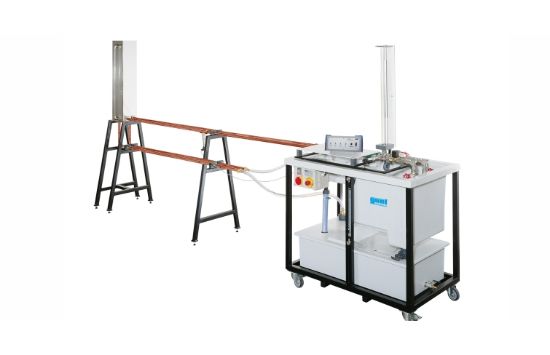In structures such as hydroelectric power plants, or in systems for supplying water, changes in flow rate result in pressure fluctuations. For example during startup and shutdown of hydraulic machines or by opening and closing shut-off elements. There is a distinction to be made between rapid pressure changes that propagate with high velocity (water hammer) and slow pressure changes caused by mass oscillations. Pipeline systems use air vessels or surge chambers to dampen water hammer and mass oscillations.
HM 156 is used to generate and visualise water hammer in pipes and to demonstrate how a surge chamber works. The trainer contains a pipe section with a ball valve and a surge chamber and a second pipe section with a solenoid valve.
In the first experiment a water hammer is produced by rapidly closing the ball valve. The sudden deceleration of the water mass releases kinetic energy, which is converted into potential energy in the surge chamber. The resulting pressure oscillations are measured by a pressure sensor behind the surge chamber and displayed in the software as a pressure curve. The oscillation can also be seen as pendulum movement of the water level in the surge chamber.
In the second experiment a rapid closing of the solenoid valve in the second pipe section produces a strong water hammer. The water’s kinetic energy is converted into pressure energy. The water hammer and the subsequent oscillations are detected by two pressure sensors in the pipe section and displayed in the software as a pressure curve.
The water is supplied and the flow rate measured by the supply unit.

Water hammer and surge chamber
In structures such as hydroelectric power plants, or in systems for supplying water, changes in flow rate result in pressure fluctuations. For example during startup and shutdown of hydraulic machines or by opening and closing shut-off elements. There is a distinction to be made between rapid pressure changes that propagate with high velocity (water hammer) and slow pressure changes caused by mass oscillations. Pipeline systems use air vessels or surge chambers to dampen water hammer and mass oscillations.
HM 156 is used to generate and visualise water hammer in pipes and to demonstrate how a surge chamber works. The trainer contains a pipe section with a ball valve and a surge chamber and a second pipe section with a solenoid valve.
In the first experiment a water hammer is produced by rapidly closing the ball valve. The sudden deceleration of the water mass releases kinetic energy, which is converted into potential energy in the surge chamber. The resulting pressure oscillations are measured by a pressure sensor behind the surge chamber and displayed in the software as a pressure curve. The oscillation can also be seen as pendulum movement of the water level in the surge chamber.
In the second experiment a rapid closing of the solenoid valve in the second pipe section produces a strong water hammer. The water’s kinetic energy is converted into pressure energy. The water hammer and the subsequent oscillations are detected by two pressure sensors in the pipe section and displayed in the software as a pressure curve.
The water is supplied and the flow rate measured by the supply unit.
